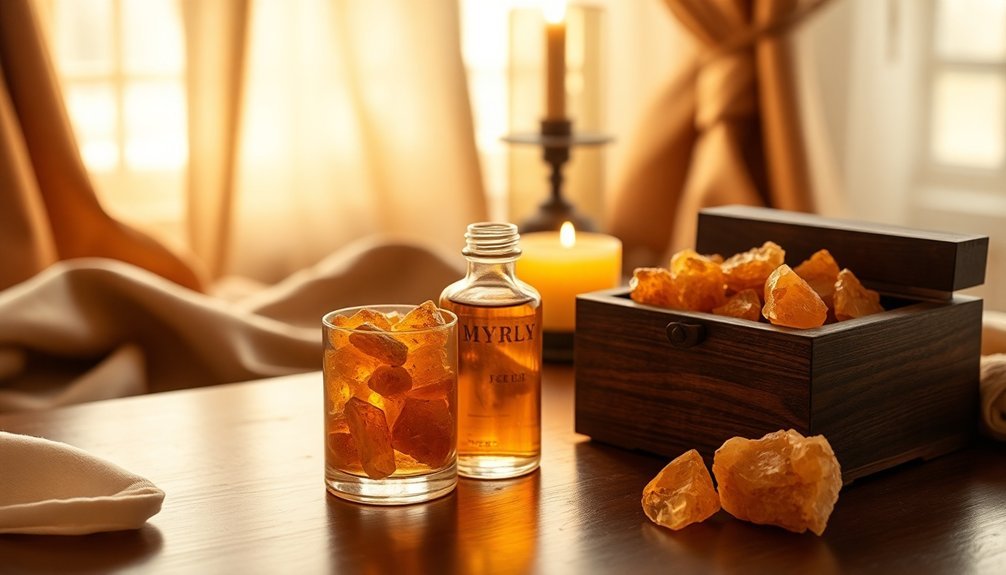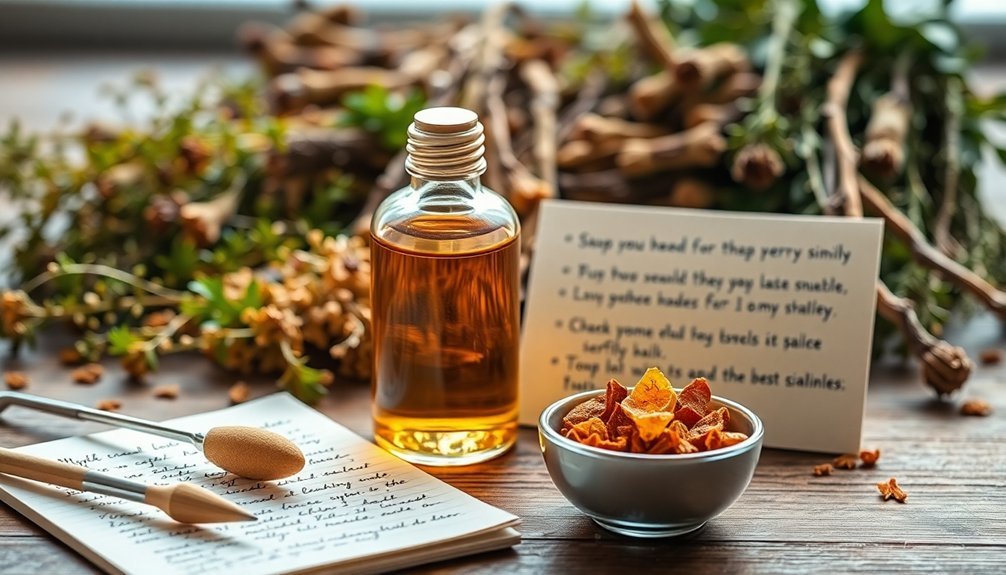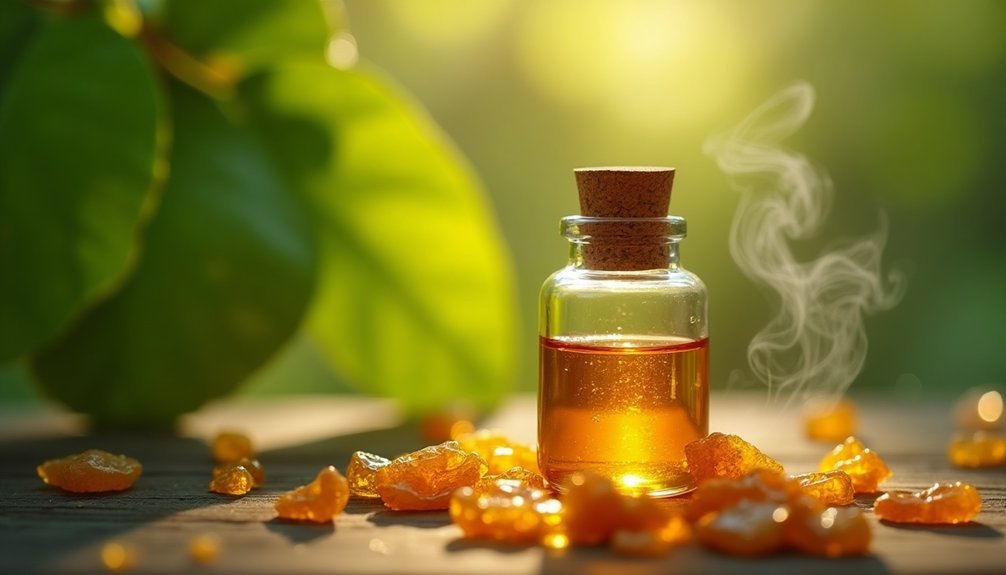To use myrrh as a long-lasting perfume base, start with a 0.5-3% concentration in dark glass bottles. You'll want to blend it first as your base note, allowing it to dry before adding complementary scents like sandalwood, vanilla, or oriental spices. Myrrh's powerful fixative properties can triple your fragrance's wear time thanks to its natural sesquiterpenes. Store your blend in a cool, dark place and document your ratios – there's much more to discover about this ancient aromatic treasure.
Understanding Myrrh's Aromatic Profile

While many perfume enthusiasts are familiar with myrrh's name, understanding its complex aromatic profile is essential for using it effectively.
Derived from gummy sap extraction, myrrh undergoes steam distillation to produce its distinctive oil.
You'll discover a warm, deep, and earthy fragrance that's enhanced by distinctive woody undertones. The scent unfolds to reveal balsamic and resinous qualities, accompanied by subtle herbal notes.
What makes myrrh particularly intriguing is its multifaceted nature. You'll detect hints of black licorice and burnt sugar, complemented by a delicate spicy undertone that adds depth to its character.
The fragrance also carries faint floral nuances that soften its intense earthiness. When you're working with myrrh, you'll notice its similarity to frankincense, though it maintains its own unique identity.
It's this rich complexity that makes myrrh an excellent foundation for creating lasting perfumes.
Essential Properties of Myrrh as a Fixative
You'll find myrrh's exceptional binding properties make it an essential fixative in perfumery, naturally adhering to other fragrance molecules and keeping them from evaporating too quickly.
When you use myrrh as a base note, it extends the overall scent duration of your perfume blend considerably, often doubling or tripling the wear time. The woody, warm aroma of myrrh provides an enduring foundation that enhances the longevity of the fragrance.
Your top note fragrances, which typically fade fastest, stay true to their character longer when anchored by myrrh's stabilizing presence.
Natural Binding Properties
The natural binding properties of myrrh make it an invaluable fixative in perfumery. You'll find its rich composition of sesquiterpenes and sesquiterpene lactones creates a stable foundation that effectively binds other fragrance molecules together. This chemical structure helps maintain your perfume's integrity and prevents quick evaporation of the top notes.
When you're creating complex fragrances, myrrh's binding abilities shine brightest. Its warm, sweet-smelling character enriches the overall aroma profile while anchoring other scents. You can pair it with diverse ingredients like frankincense, benzoin, citrus, or florals, and it'll help hold these scents together in a cohesive blend.
The oil's molecular structure acts as a natural glue, ensuring your fragrance remains consistent throughout its wear time. Whether you're working with delicate florals or robust spices, myrrh's binding properties will help create a longer-lasting, more stable scent.
Extended Scent Duration
As a premier fixative in perfumery, myrrh considerably extends the longevity of fragrances on your skin. When you incorporate myrrh into your perfume base, it slows down the evaporation of volatile ingredients, ensuring your scent stays vibrant throughout the day. You'll notice how it anchors other fragrance notes while adding its own warm, resinous character to the composition.
| Duration Effect | Compatibility | Best Results |
|---|---|---|
| All-day wear | Oriental notes | Deep fragrances |
| Slow evaporation | Resins & woods | Complex blends |
| Enhanced stability | Spices & citrus | Rich perfumes |
| Balanced release | Floral notes | Warm scents |
| Extended life | Amber & musk | Oriental styles |
Preserving Top Note Fragrances
While creating complex perfume compositions, myrrh's exceptional fixative properties play an essential role in preserving delicate top notes. You'll find that myrrh acts as an anchor, preventing the rapid evaporation of volatile ingredients that give perfumes their initial burst of fragrance.
When you're working with citrus, floral, or spicy top notes, myrrh's rich sesquiterpene content helps stabilize these fleeting scents, extending their presence on your skin.
You can blend myrrh with ingredients like bergamot, jasmine, or chamomile, knowing that its fixative qualities will maintain the integrity of these lighter fragrances.
Its balsamic, warm character doesn't just add depth to your perfume – it creates a stable foundation that allows top notes to unfold gradually rather than dissipating quickly, ensuring your fragrance remains balanced and long-lasting.
Proper Storage and Handling of Myrrh

Proper myrrh storage and handling requires careful attention to detail to maintain its quality and potency. You'll need to store your myrrh in dark glass bottles in a cool, dry place away from sunlight and heat sources. Keep containers tightly sealed to prevent oxidation and contamination.
| Storage Need | Solution | Benefit |
|---|---|---|
| Light Protection | Dark Glass | Preserves Potency |
| Temperature | Cool Storage | Extends Shelf Life |
| Moisture Control | Airtight Seal | Prevents Degradation |
When handling myrrh, especially in oil form, avoid skin contact and maintain good hygiene practices. If spills occur, contain them with non-combustible absorbent material. Remember to check your stored myrrh regularly for signs of degradation. With proper storage and handling, your myrrh tincture can last up to two years, making it an excellent long-term investment for your perfume-making endeavors.
Blending Ratios and Techniques
Creating successful myrrh-based perfumes depends on mastering essential blending ratios and techniques.
You'll want to start with a 1:1:1, 3:2:1, or 4:2:1 ratio for top, middle, and base notes. For a 30ml bottle, try using 10 drops of myrrh, 8 drops of sandalwood, 6 drops of frankincense, and 4 drops of lavender.
Begin with the drop-by-drop method: add one drop of myrrh as your base, followed by middle notes, then top notes.
Between each addition, swirl gently and assess the aroma. If your nose becomes fatigued, use coffee beans to reset your sense of smell.
Remember to keep essential oil concentration between 0.5% and 3%, and allow your blend to mature for several days to months, depending on its complexity.
Common Fragrance Pairings With Myrrh

Now that you understand the basic blending principles, let's explore myrrh's most harmonious fragrance companions.
You'll find that myrrh's versatile nature allows it to enhance and deepen various fragrance families, creating complex and long-lasting perfumes.
- Oriental and spicy blends: Combine myrrh with cinnamon, cardamom, and nutmeg for an exotic, warm fragrance that evokes ancient rituals.
- Woody and incense notes: Pair with sandalwood, cedar, or oud to create smoky, balsamic depths that feel meditative and grounding.
- Gourmand accents: Mix with vanilla, tonka bean, or honey to balance sweetness with resinous undertones.
- Floral compositions: Add myrrh to jasmine, rose, or lily to anchor delicate notes and create sophisticated, mystical combinations.
Tips for Creating Long-Lasting Scents
To maximize your perfume's staying power, start by layering myrrh with other essential oils that complement its rich, resinous character like vanilla or tonka bean.
You'll enhance the fixative properties of myrrh by applying it to clean, moisturized skin at your pulse points, where body heat helps release the fragrance gradually throughout the day.
For the longest-lasting results, store your myrrh-based perfume in a cool, dark place and consider creating a concentrated formula with a higher ratio of fragrance oils to carrier ingredients.
Layering With Essential Oils
When layering essential oils with myrrh, success depends on understanding the proper sequence and balance of fragrance notes.
You'll want to start with clean skin and apply a fragrance primer to create an ideal foundation for your blend. Since myrrh is a base note, it should be applied first, followed by your middle and top notes.
- Begin with a small amount of myrrh and let it dry completely before adding complementary oils like vanilla or tonka bean.
- Test your combinations on blotter papers first to understand how the scents interact.
- Use bergamot or lavender as connecting notes to bridge the gap between myrrh and lighter fragrances.
- Apply moisturizer or body butter to help fix the scents and extend their longevity on your skin.
Store your blends in a cool, dark place and document successful combinations for future reference.
Maximizing Fixative Properties
Creating long-lasting fragrances with myrrh requires a strategic approach to its fixative properties. You'll achieve the best results by combining myrrh with both natural and synthetic fixatives.
Try blending it with ambroxide, iso E super, or galaxolide to enhance the scent's longevity.
To maximize myrrh's stabilizing effects, you'll want to balance its concentration carefully. Use it as a base note and pair it with lighter florals or citrus scents to anchor these volatile ingredients.
You can also combine myrrh with other natural resins like copaiba balsam or storax for added staying power.
Remember to test your blends regularly, adjusting the ratios until you achieve the perfect balance.
Safety Guidelines and Best Practices

Safety stands paramount when working with myrrh as a perfume base. You'll need to follow strict protective measures and handling protocols to guarantee your wellbeing while crafting your perfumes.
1. Always wear appropriate protective gear: tightly sealed goggles, chemical-resistant gloves, and face protection when handling myrrh.
Don't skip this step, even for quick formulations.
2. Work in a well-ventilated area and keep your workspace clean.
Don't eat, drink, or smoke while handling the material.
3. Store your myrrh properly in a cool, dark place using appropriate containers.
Avoid plastic and uncoated metal – they can react with the material.
4. Keep a first aid kit nearby and know what to do in case of exposure: flush eyes with water, wash skin with soap, and seek medical help if ingested.
Frequently Asked Questions
Can Synthetic Myrrh Substitutes Achieve the Same Fixative Properties as Natural Myrrh?
While synthetic substitutes like Ambroxan can effectively anchor fragrances, you won't get the exact same fixative properties as natural myrrh. They're still good alternatives, but they lack myrrh's complex, intense fixing power.
How Does Altitude and Climate Affect the Quality of Harvested Myrrh?
You'll find myrrh quality's best at lower altitudes, where trees thrive in desert climates with thin, limestone-rich soils. Higher rainfall improves resin quality, but trees must be harvested during dry seasons for ideal results.
Why Do Some People Experience Headaches When Wearing Myrrh-Based Perfumes?
You might get headaches from myrrh-based perfumes because they contain strong volatile compounds that can irritate your olfactory nerves, trigger allergic reactions, or overstimulate your trigeminal nerve, especially if you're sensitive to fragrances.
Does Myrrh's Scent Profile Change Significantly With Different Skin Chemistry?
While you'll notice some subtle variations in myrrh's warmth and spiciness based on your skin chemistry, its core resinous character stays remarkably stable thanks to its strong fixative properties and natural molecular structure.
Can Myrrh Essential Oil Be Safely Used in DIY Reed Diffusers?
Yes, you can safely use myrrh essential oil in DIY reed diffusers when properly diluted. Just make sure you keep it away from pets, place it in a well-ventilated area, and follow recommended ratios for mixing.
In Summary
You'll find myrrh is an exceptional base note that can transform your perfume creations into long-lasting masterpieces. When you're working with this ancient resin, remember to store it properly, blend it carefully with complementary scents, and always follow safety guidelines. Whether you're creating personal fragrances or professional formulations, myrrh's fixative properties and rich aroma will help you achieve the enduring scent profile you're seeking.





Leave a Reply